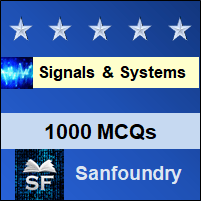
Signals & Systems Multiple Choice Questions Highlights
- 1000+ Multiple Choice Questions & Answers (MCQs) in Signals & Systems with a detailed explanation of every question.- These MCQs cover theoretical concepts, true-false(T/F) statements, fill-in-the-blanks and match the following style statements.
- These MCQs also cover numericals as well as diagram oriented MCQs.
- These MCQs are organized chapterwise and each Chapter is futher organized topicwise.
- Every MCQ set focuses on a specific topic of a given Chapter in Signals & Systems Subject.
Who should Practice Signals & Systems MCQs?
– Students who are preparing for college tests and exams such as mid-term tests and semester tests on Signals & Systems.- Students who are preparing for Online/Offline Tests/Contests in Signals & Systems.
– Students who wish to sharpen their knowledge of Signals & Systems Subject.
- Anyone preparing for Aptitude test in Signals & Systems.
- Anyone preparing for interviews (campus/off-campus interviews, walk-in interview and company interviews).
- Anyone preparing for entrance examinations and other competitive examinations.
- All - Experienced, Freshers and College / School Students.
Signals & Systems Chapters
Here's the list of chapters on the "Signals & Systems" subject covering 100+ topics. You can practice the MCQs chapter by chapter starting from the 1st chapter or you can jump to any chapter of your choice.- Signals and Systems Basics
- Time-Domain Analysis of CT Systems
- Time Domain Representation for LTI Systems
- Linear Algebra Overview
- Fourier Series
- Hilbert Spaces and Orthogonal Expansions
- Fourier Analysis on Complex Spaces
- Convergence
- Fourier Transform
- Sampling Theorem
- Laplace Transform and System Design
- Z-Transform and Digital Filtering
- Signal Transmission Through Linear Systems
1. Signals and Systems Basics
The section contains multiple choice questions and answers on system and signal classification and its properties, elementary signals and signals operations, discrete time signals, useful signals, circuit applications, periodic and non periodic signals, complex exponential, discrete time systems, impulse function and bibo stability.
2. Time-Domain Analysis of CT Systems
The section contains questions and answers on continuous and discrete time convolution, lti systems properties.
3. Time Domain Representation for LTI Systems
The section contains MCQs on convolution and properties of impulse response representation for lti systems.
|
|
|
4. Linear Algebra Overview
The section contains multiple choice quesions and answers on linear algebra basics, vector basics, eigen vectors and functions of lti systems, matrix diagonalization and eigen values.
|
|
|
5. Fourier Series
The section contains questions and answers on periodic signals, fourier series, fourier coefficients, fourier series properties, lti systems, trigonometric fourier series, average power, power and energy signals, exponential fourier series, symmetry properties of fourier series, dirichlet conditions, gibbs phenomena, circular convolution properties and lti systems.
6. Hilbert Spaces and Orthogonal Expansions
The section contains MCQs on vector spaces, norms, inner products, hilbert spaces, cauchy schwarz inequality, basis types, orthonormal basis expansions, function space, haar wavelet basis, plancharel theorems and hilbert space projections.
|
|
|
7. Fourier Analysis on Complex Spaces
The section contains multiple choice questions and answers on fourier analysis and also in complex spaces, matrix equation for dtfs, fourier analysis using circuits, periodic extensions to dtfs, circular shifts, circular convolution, dft, fast fourier transform and its derivation.
|
|
|
8. Convergence
The section contains questions and answers on convergence of sequences and vectors, uniform convergence of function sequences.
|
|
|
9. Fourier Transform
The section contains MCQs on fourier transforms and its properties, inverse fourier transform, discrete fourier transformation, common and discrete time fourier transforms, dtft properties, dtft pair, dtft examples, ctft and its properties.
|
|
|
10. Sampling Theorem
The section contains multiple choice questions and answers on sampling, reconstruction, nyquist theorem, discrete time processing of continous time signals, aliasing and anti-aliasing filters.
|
|
|
11. Laplace Transform and System Design
The section contains questions and answers on laplace transform and its properties, bilateral laplace transform, common laplace transforms, convergence region, roc properties, systems characterization and nature, inverse laplace transform, poles and zeros.
|
|
|
12. Z-Transform and Digital Filtering
The section contains MCQs on z-transform and its properties, common and inverse z-transforms, rational functions, difference equations, zero plots on the z-plane, filter designs, bode plots, filters types, feedback systems, state space model and differential equations.
|
|
|
13. Signal Transmission Through Linear Systems
The section contains multiple choice questions and answers on convolution concept, ideal lpf, hpf, bpf and bsf characteristics.
|
|
|
Wish you the best in your endeavor to learn and master Signals & Systems!
